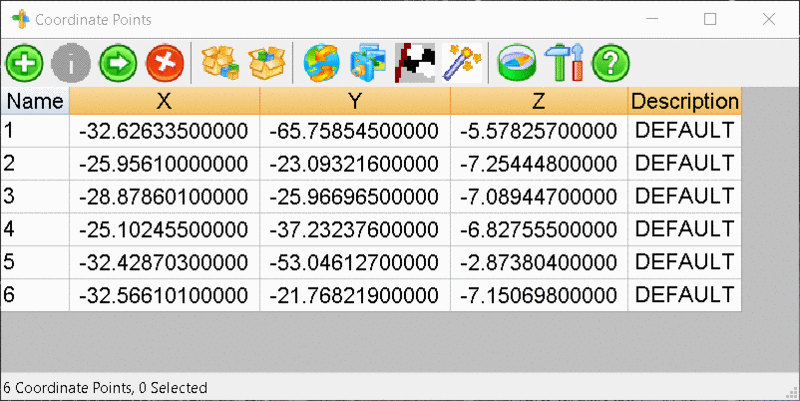
The Point Editor can be opened by right-mouse clicking on a set of points in the Current Project tree and selecting Edit or by double clicking on a set of points. In the Coordinate Points window, there are several base functions that are shared across all point types, with some extended options added for certain points types.

Along the top toolbar are several option buttons:

|
Add Point brings up a dialog that allows you to specify the properties of a new point to add. |

|
Edit brings up the point edit dialog which allows you to change properties of the currently selected point. |

|
Copy Points allows you to copy the currently selected points to another point set (such as from the control points to the target points of a scan). |

|
Delete deletes the currently selected points. |

|
Import Points brings up the ASCII file import dialog. |

|
Export Points brings up the ASCII file export dialog. |

|
Transform allows you to define a transformation sequence to apply to the points. |

|
View brings up the scene creation dialog for viewing the current point set. |

|
Field to Finish Draws the selected points in CAD using the current FLD file and field to finish settings. |

|
Draw to CAD brings up the Point Draw Settings dialog specify a layer to draw the selected points on in CAD and specify if the points should be added to the current CRD file. |

|
Coordinate System allows you to choose the coordinate system the positions values are in (Global or any current scan positions). |

|
Settings allow you to configure what properties of the points are visible in the spreadsheet control. |

|
Help brings up help documentation. |
The Target Points editor has an additional toolbar button:

|
Register begins the scan registration process for the current set of target points. |
Clicking the Add Point button will open the
New Coordinate Point window.
Name is a unique name for the point to be used to identify it in PointCloud.
X, Y, and Z are the x, y, and z coordinates values for the new point to be added.
Description is a description for the point.
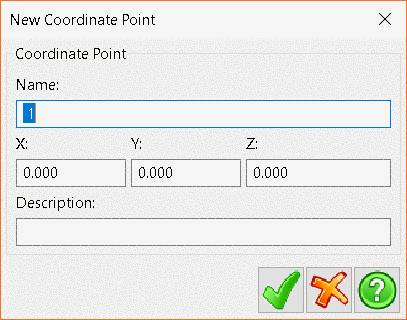
Clicking the Import Points button will open the
Import Coordinate Points file selection dialog. The file
formats currently supported for import are TXT, CSV,
CRD and CRDB. Navigate to the correct file and click
Open to display the Import Coordinate Points
window.
Selecting Rename all items will rename all
imported points to the settings specified in the Naming
Conventions settings. The Duplicate Entries
panel will specify the action to take when a point being imported
has a name that already exists in the set of points being imported
to.
Click the Green Tick to import the points.
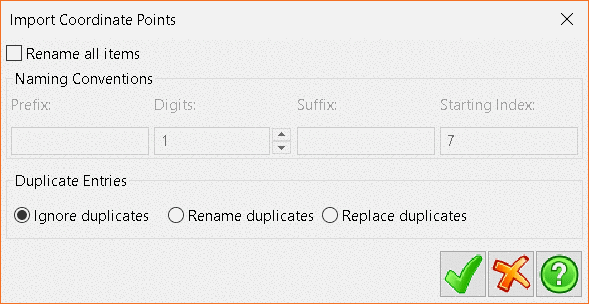
Clicking the Export Points button will open the Export
Coordinate Points window, which allows users to export the data
to several different file formats.
In the Columns panel, click on the check boxes to include or
exclude the data elements. To change the order of the data elements
in the file, click on the element and then click the up or down
arrows to adjust its position.
The File panel determines which file format to
export to and also allows you to specify an extension other than
the default for a given file format.
The Text panel contains options when exporting to
the different text file types, ANSI Text or Unicode
Text. The Delimiter Type determines the
divider between data elements in the file. The Write
header option specifies whether to write a header line to
the file detailing the data ordering of the file.
Microsoft Excel allows the user to define the name of the
Excel worksheet that the points will be exported to. Note:
only available when exporting as Format: Microsoft
Excel.
XML allows users to define the Root and
Collection values and choose to Format data.
Note: only available when exporting as
Format:XML.
GCP - when exporting as GCP, click on the Set button
to choose the Coordinate Projection. Users can choose to select a
Pre-Defined projection, add a projection from a file or create a
User-Defined projection on the fly. Click OK to select and
return to the previous window. Users can select to export the
coordinates in Latitude/Longitude format and also to select the
appropriate units; Metric, US Feet or
International Feet.
Users can select a preset export format by selecting it from the
Presets drop-down menu. To define a new preset, include or
exclude the desired data elements in the Columns panel,
organise the elements into the desired order and then click the
Green Plus button next to the Presets drop-down. The
new preset will be added to the drop-down menu for future
use.
To delete a preset, select it from the Presets drop-down
menu and then click the Green Dash button next to the
Presets drop-down menu.
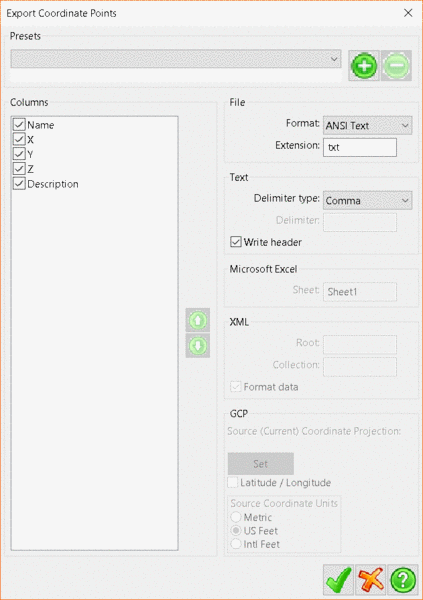
The Transform button opens the Transform Coordinate
Points window where users can define a selection of
transformation parameters to apply to the selected Coordinate
Points.
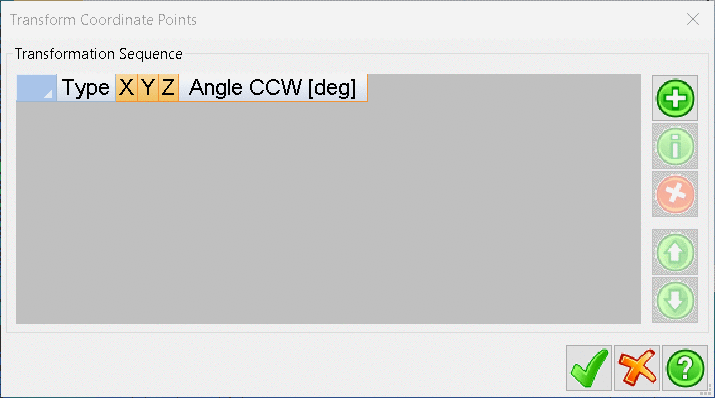
Initially, the dialog will have no transformations specified. To
add a transformation, press the Green
Plus button. which will open
the New
Tranformation window.
Use the Type drop-down
menu to select one of the four Transformation types:
Translate allows the user to define a translation of the current data set by specifying offsets in X, Y and Z.
Rotations allow the user to rotate the current selection set by specifying rotations around the X Y and Z axis.
Scaling allows the user to scale the current selection by a set Factor in the X, Y and Z axis.
Advanced allows the user to specify a transformation matrix to be applied to the data.
After clicking the check button you should be taken back to
the Transform
Coordinate Points
window. From here users can add more transformations, modify the
currently selected one by pressing
the Green
i button,
delete them by pressing the Red
X button,
or change their order of application to the data using the
Green arrow buttons.
Press the Green
Tick button
to apply the transformations.
Note: Transformations are applied in top-to-bottom
order.

The Settings button will bring up the Coordinate Point Settings window, which allows the user to configure which data elements of the current point set are visible, as well as the order that they are displayed in.
To turn off a data element so it will not be displayed, click in
the check box next to that element in the Columns
panel.
To change the order that data elements are displaued, select the
element to move and then click the green up and down arrows to
adjust the elements position.
Users can select a preset export format by selecting it from the
Presets drop-down menu. To define a new preset, include or
exclude the desired data elements in the Columns panel,
organise the elements into the desired order and then click the
Green Plus button next to the Presets drop-down. The
new preset will be added to the drop-down menu for future
use.
To delete a preset, select it from the Presets drop-down
menu and then click the Green Dash button next to the
Presets drop-down menu.
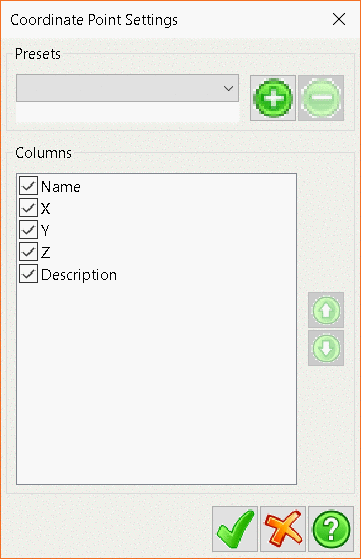
Tab Location(s): Project Tab
Access Command: Right-Click Points and select Edit
Prerequisite: Control Points or Target Points or Coordinate
Points